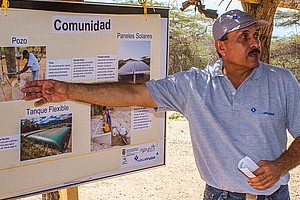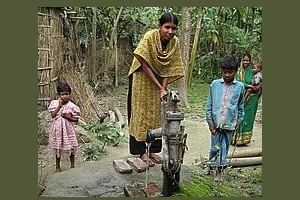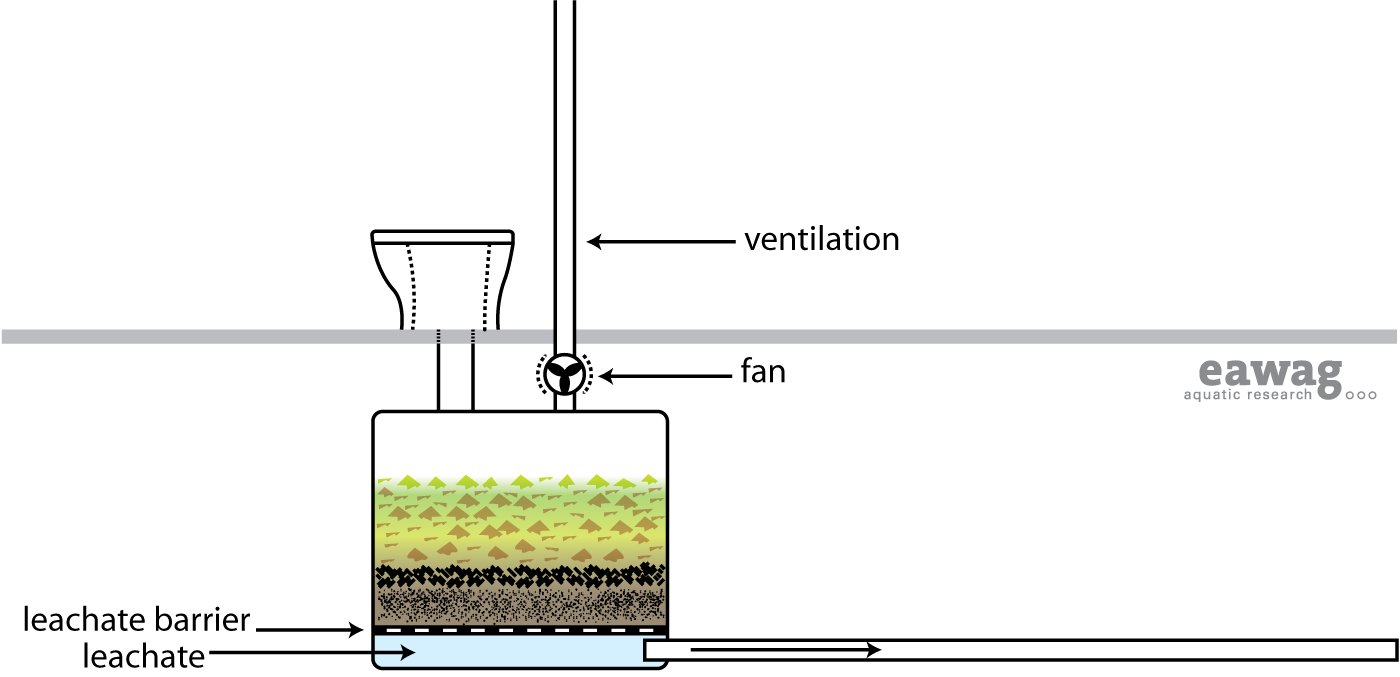Composting Chamber
|
|
|||||||||||||||||||||||||||
Composting refers to the process by which biodegradable components are biologically decomposed by microorganisms (mainly bacteria and fungi) under aerobic conditions. A composting chamber is designed to convert excreta and organics into compost. Compost is a stable, inoffensive product that can be safely handled and used as a soil conditioner.
This technology usually requires four main parts:
- a reactor (storage chamber);
- a ventilation unit to provide oxygen and allow gases (CO2, water vapour) to escape;
- a leachate collection system ; and
- an access door to remove the mature product.
Excreta, organics, food waste and bulking material (such as wood chips, sawdust, ash or paper) are mixed in the chamber. There are four factors that ensure the good functioning of the system: (a) sufficient oxygen, provided by active or passive aeration; (b) proper moisture (ideally 45 to 70% moisture content); (c) internal (heap) temperature of 40 to 50 °C (achieved by proper chamber dimensioning); and (d) a 25:1 C:N ratio (theoretically) which can be adjusted by adding bulking material as a carbon source. In practice, these optimal conditions are difficult to maintain. As a result, the output product is often not sufficiently stabilized and sanitized, and requires further treatment.
Contents
Design Considerations
A composting chamber can be designed in various configurations and constructed above or below ground, indoors or with a separate superstructure. A design value of 300 L/person/year can be used to calculate the required chamber volume. Ventilation channels (air ducts) under the heap can be beneficial for aeration. More complex designs can include a small ventilation fan, a mechanical mixer, or multiple compartments to allow for increased storage and degradation time. A sloped bottom and a chamber for compost withdrawal facilitate access to the final product. A drainage system is important to ensure the removal of leachate. Excessive ammonia from urine inhibits the microbial processes in the chamber. The use of a Urine-Diverting Dry Toilet (UDDT, U.2) or Urinal (U.3) can, therefore, improve the quality of the compost.
| Advantages | Disadvantages/limitations |
|---|---|
| - Significant reduction in pathogens - Compost can be used as a soil conditioner |
- Requires well-trained user or service personnel for monitoring and maintenance - Compost might require further treatment before use |
Appropriateness
Since this technology is compact and waterless, it is especially suited in areas where land and water are limited, or when there is a need for compost. It can also be installed in rocky areas, or where the groundwater table is high. In cold climates, a composting chamber should be indoors to ensure that low temperatures do not impede the microbial processes. This technology cannot be used for the collection of anal cleansing water or greywater; if the reactor becomes too wet, anaerobic conditions will cause odour problems and improper degradation.
Health Aspects/Acceptance
If the composting chamber is well designed, the users will not have to handle the material during the first year. A well-functioning composting chamber should not produce odours. If there is ample bulking material and good ventilation, there should be no problems with flies or other insects. When removing the final product, it is advisable to wear protective clothing to prevent contact with (partially) composted material.
Operation & Maintenance
Although simple in theory, composting chambers are not that easy to operate. The moisture must be controlled, the C:N ratio must be well balanced and the volume of the unit must be such that the temperature of the compost pile remains high to achieve pathogen reduction. After each defecation, a small amount of bulking material is added to absorb excess liquid, improve the aeration of the pile and balance the carbon availability. Turning the material from time to time will boost the oxygen supply.
A squeeze test can be made to check the moisture level within the chamber. When squeezing a handful of compost, it should not crumble or feel dry, nor should it feel like a wet sponge. Rather, the compost should leave only a few drops of water in one’s hand. If the material in the chamber becomes too compact and humid, additional bulking material should be added. If a UDDT is used, some water should be added to obtain the required humidity. Depending on the design, the composting chamber should be emptied every 2 to 10 years. Only the mature compost should be removed. The material may require further treatment to become hygienically safe (e.g., Co-Composting, see T.16). With time, salt or other solids may build up in the tank or drainage system. These can be dissolved with hot water and/or scraped out.
Upgrading
A simple Composting Chamber can be upgraded to include a small ventilation fan, a mechanical mixer, or multiple compartments to allow for increased storage and degradation time.
Field experiences
The following projects utilize composting chamber methods.
 MWA-LAP: Colombia |
 WaSH program in Rural Bangladesh |
References
- Berger, W. (2011). Technology Review of Composting Toilets. Basic Overview of Composting Toilets (with or without Urine Diversion). Gesellschaft für Internationale Zusammenarbeit (GIZ) GmbH, Eschborn, DE.
- Del Porto, D. and Steinfeld, C. (1999). The Composting Toilet System Book. A Practical Guide to Choosing, Planning and Maintaining Composting Toilet Systems, an Alternative to Sewer and Septic Systems (Book). The Center for Ecological Pollution Prevention (CEPP), Concord, MA, US.
- Hill, G. B., Baldwin, S. A. and Vinnerås, B. (2013). Composting Toilets a Misnomer: Excessive Ammonia from Urine Inhibits Microbial Activity yet Is Insufficient in Sanitizing the End-Product. Journal of Environmental Management 119 (2013): 29-35.
- Jenkins, J. (2005). The Humanure Handbook. A Guide to Composting Human Manure (Book). 3rd Ed. Jenkins Publishing, Grove City, PA, US.
- U.S. EPA (1999). Water Efficiency Technology Fact Sheet. Composting Toilets. EPA 832-F-99-066. U.S. Environmental Protection Agency, Washington, D.C., US.
Acknowledgements
The material on this page was adapted from:
Elizabeth Tilley, Lukas Ulrich, Christoph Lüthi, Philippe Reymond and Christian Zurbrügg (2014). Compendium of Sanitation Systems and Technologies, published by Sandec, the Department of Water and Sanitation in Developing Countries of Eawag, the Swiss Federal Institute of Aquatic Science and Technology, Dübendorf, Switzerland.
The 2nd edition publication is available in English. French and Spanish are yet to come.


